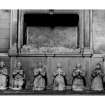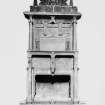Culross Abbey, Bruce Of Carnock Vault
Burial Vault (17th Century), Commemorative Monument (17th Century)
Site Name Culross Abbey, Bruce Of Carnock Vault
Classification Burial Vault (17th Century), Commemorative Monument (17th Century)
Canmore ID 364470
Site Number NS98NE 3.10
NGR NS 98894 86259
Datum OSGB36 - NGR
Permalink http://canmore.org.uk/site/364470
- Council Fife
- Parish Culross
- Former Region Fife
- Former District Dunfermline
- Former County Fife
Field Visit (31 August 1927)
The Bruce of Carnock vault (1642) contains an important Renaissance mural monument. It is signed IOHN MERCER FECIT. At the top, within a strap-worked pediment, is a blazon. The shield, supported by 'wodehouses' or wild men, is surmounted by helm and mantling and bears: A saltire, on a chief three mullets; a label below the shield is inscribed, SIR GEORGE BRVCE, and his initials appear on the central console beneath the main cornice. In the centre part of the monument are two shields, of which the dexter is charged for Bruce, while the sinister shield bears: On a fess three mullets between three primroses in chief and a primrose in base, for his wife Margaret Primrose. These shields depend from swags and enclose a panel inscribed: THIS. IS. SIR. GEORGE. BRVCE . OF. CARNOCK/HIS . LADY. HIS. THREE. SONS. AND . FIVE. DAVG/HTERS . THIS . TOMB . WAS . PROVIDED . BY . GEORG/E . BRVCE . OF CARNOCK . HIS . ELDEST . SON. Sir George Bruce died in 1625. The parents are represented by life-sized recumbent effigies of alabaster set in a niche in the lower part of the tomb. Above the niche are the inscriptions: SI MORTVI NON RESVRGVNT / NEQVE CRISTVS RESVREXIT : RESVREXIT AVTEM ET FACTVS / EST PRIMITIÆ OBDORMIENTIVM (It If the dead rise not, then is not Christ raised. But now is Christ risen from the dead, and become the first fruits of them that slept." I Corinthians, xv, 16, 20.) The niche has been slightly cut away to admit the male figure, and it is most probable that Mercer was not responsible for the figure work* but only for its setting. In front of the tomb are half-sized figures of the family, also of alabaster, who are represented as kneeling on cushions. The effigies, which are obviously portraits, are of high artistic merit and afford a most valuable guide to the costume of the period. The children were George (of Carnock), Alexander (of Alva), Robert (a Lord of Session, and therefore not in armour), Anne, Magdalene, Christian, Nicholas, Margaret. The figures are actually movable and not fixed down.
RCAHMS 1933, visited 31 August 1927
*Mrs. Esdaile considers the figures to be "exactly like the work of Edward Marshall" (1578-1675). For this English sculptor, who became Master Mason to Charles II, see her book on English Monumental Sculpture since the Renaissance. She also holds that originally "the figures would have knelt in profile, sons and daughters separate, and facing each other."












![Culross Abbey.
View of tomb of Sir George Bruce of Carnock.
Scanned from glass plate negative. Original envelope annotated by Erskine Beveridge 'Bruce Mon[umen]t, Culross'](http://i.rcahms.gov.uk/canmore/l/SC01129183.jpg)







![Culross
View of tomb of Sir George Bruce of Carnock.
Scanned from glass plate negative. Original envelope annotated by Erskine Beveridge 'Bruce Mon[umen]t, Culross'](http://i.rcahms.gov.uk/canmore/l/SC01129184.jpg)






![Culross Abbey.
View of tomb of Sir George Bruce of Carnock.
Scanned from glass plate negative. Original envelope annotated by Erskine Beveridge 'Bruce Mon[umen]t, Culross'](http://i.rcahms.gov.uk/canmore/s/SC01129183.jpg)







![Culross
View of tomb of Sir George Bruce of Carnock.
Scanned from glass plate negative. Original envelope annotated by Erskine Beveridge 'Bruce Mon[umen]t, Culross'](http://i.rcahms.gov.uk/canmore/s/SC01129184.jpg)
